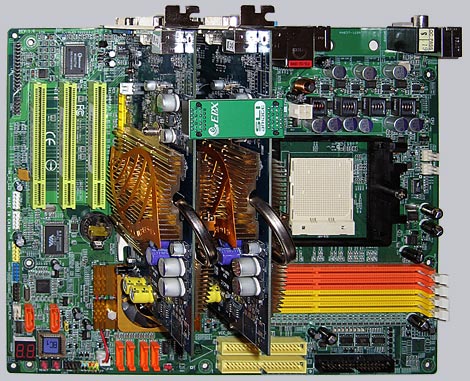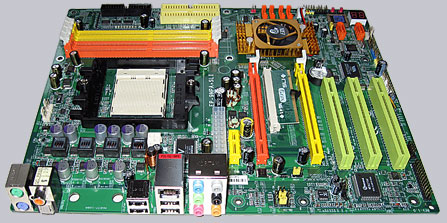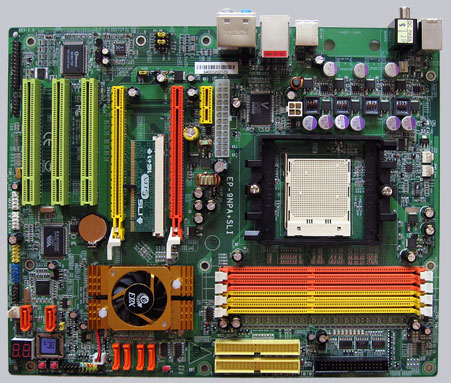
Result and general impression

++++ The EPoX 9NPA+ SLI PCIe Socket 939 board costs at present approx. 120 euro (03/2006) and is appropriate thereby in the mid to upper price segment of all still reviewed Socket 939 PCIe SLI motherboards.
Usually SLI motherboards (2 PCIe video card slots) offers only place for 2 PCI Slots due to the standardized ATX motherboard size. But EPoX offers with this 9NPA+ SLI Socket 939 board 2x PCIe 16x video card slots and 3x PCI !!! Card slots, which makes it possible to use more than enough PCI extension cards. Thus the space near the ATX power connector gets a little bit less, but even bigger CPU cooler finds sufficiently air near the video cards.
On this picture you can see both empty PCIe 16x Slots and the small SLI mode PCB, which have to turn around for the SLI mode:
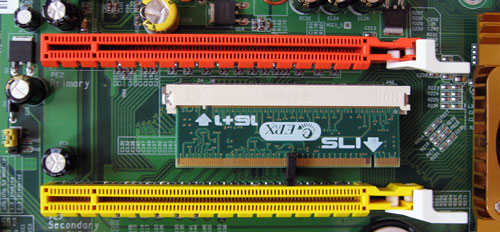
Then both PCI Express Cards are put in and both video cards have to be connected with the SLI Link Bridge Card:
Let us go on with the additional equipment, which the 9NPA+ SLI Motherboard offers. The EPoX 9NPA+ SLI manage two PCIe Slots and an additional S-ATA II RAID controller, except this it has similar equipment characteristics as the 9NPA+ Ultra board tested before. The nVidia nForce4 Ultra chipset manage the four S-ATA II RAID (0/1/0+1) connectors with up to 3 GB/s data-rate, 2 connectors for up to 4 UDMA 133 (P-ATA) hard disks and up to four DDR memory modules with Dual Channel support.
Additionally EPoX gave this board still another Sil 3132 chip, for two additional S-ATA II RAID (0/1/0+1) connectors, whereby the nForce 4 controller should be preferred due to a smaller CPU load and somewhat better performance.
As sound chip the 8-channel ALC 850 is used on this board, which is able to give support for up to 8 sound channels by 6x 3.5mm jacks. And instead of the integrated 10/100 chipset NIC EPoX use the Vitesse 8201 LAN chip, which provides up to 1 Gigabit network speed and is thus optimally for a fast home network.
Here’s a picture of another new EPoX characteristic. They offer beside the 7-segment post code display (to examine possible start up errors) newly 2 small buttons for Power and Reset:
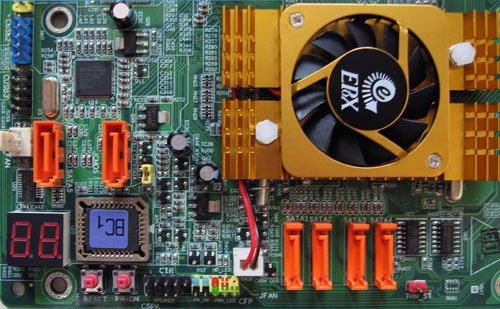
The two buttons for power and reset are optimal for any work inside of the PC case, since one doesn’t have to attach any frontpanel cable to switch ON or reset the PC system. After switching on the PC possible error diagnostics succeeds more simply, because there’re 3 additional blue LEDs integrated which indicates the status of the chipset (LED1), the status of the memory modules (LED2) and of the CPU (LED3).
Another Modding highlight is the display of the hard disk activity with a small LED line … rather senseless but nice to watch 😉
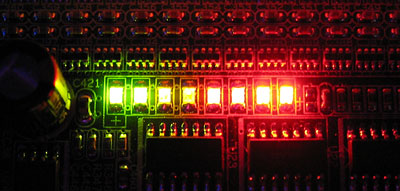
The BIOS offers dozens interesting options, e.g. gigantic memory settings to adjust the used memory modules optimally. In addition, the adjustment of the Vcore (CPU voltage) is awesome with the 9NPA+ SLI, because it’s possible to increase the Vcore (as mentioned in the current Socket 939 Pinmod guide) with additional +0.35 V up to 1.90 Volt CPU voltage! However, such a high Vcore is surely recommended only for extreme overclocker and requires very good CPU cooling like e.g. water cooling or compressor cooling. And who don’t like to set the Vcore manually, can select the BIOS Vcore option to “Auto”. This doesn’t mean that you set it to the default Vcore (this is the option “OFF”). No, this option will give the CPU as high voltage which is necessary to run the overclocked CPU.
The integrated monitoring of the boot process was checked several times by the test procedures and automatically starts an incorrect PC boot up (e.g. because of too high overclocking), by setting all frequencies and multiplier to default values. So it’s not necessary to set the Clear CMOS jumper when you’ve overclocked too much.
And when a board offers so many overclocking features, of course also overclocking tests may not be missed in this motherboard test report.
The HT reference clock reach even without increasement of the chipset voltage stable up to awesome 330 MHz, which is so far the highest reference frequency with default chipset voltage. The active chipset cooling ensures a good heat dissipation of the nForce 4 ultra chipset. Fortunately the chipset fan get its power supply via an additional 2-Pin connector, so that furthermore all 4 fan connectors are still usable for other cooling devices like case fans, etc.
To stable ensure this high achievement, several high-quality Capacitors are integrated and small passive heatsinks are in the scope of delivery to cool the power transistors.
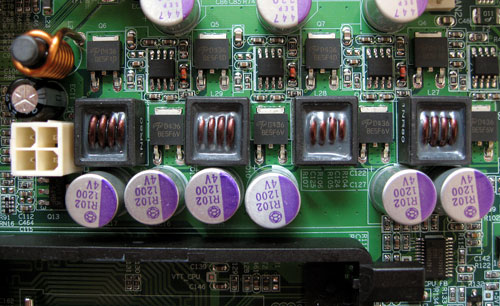
But thus yet not enough cooling, because EPoX delivers the I/O Shield without the SUB-D plug for conventional LPT and COM Ports. Instead of these ports, EPoX use an ATX I/O Shield with a small 40mm rear I/O Fan. However it’s somewhat unfortunate that they deliver the board without Slot bracket for the onBoard COM & LPT Port connectors.
Result: The EPoX 9NPA+ SLI Socket 939 PCI express motherboard offers in addition to the two 16x PCIe SLI video card slots even three PCI card slots, four dual Channel DIMM Slots, six RAID 0/1/0+1 capable S-ATA II connectors, 8 channel sound chip, 1 Gigabit LAN with integrated Firewall and an extensive software package. This AMD Socket 939 board has overclock options in barrels and the EPoX 9NPA+ SLI reach in the test in spite of the original chipset voltage the highest HT reference clock of 330 MHz, so that also a processor with locked multiplier can reach unexpected clock frequency. The voltage adjustment and the cooling is also very good, so that overclocking is mere child’s game. All in all the EPoX 9NPA+ SLI motherboard has hard-earned the Redaktion ocinside.de OverClocking Dream Award 03/2006 !
Special thanks to EPoX
for their support.
**** All Socket 939 motherboard reviews since 01.11.2005 are based on an AMD Athlon 64 3000+ Venice processor, 1x (or SLI systems with 2x) Gigabyte GV-NX66T128VP Nvidia 6600 GT PCI Express video cards and the following software configuration: Microsoft Windows XP SP2, DirectX 9.0c, Forceware 81.85 video driver and 3DMark 2003. All benchmark results should only offer a comparison among themselves.


